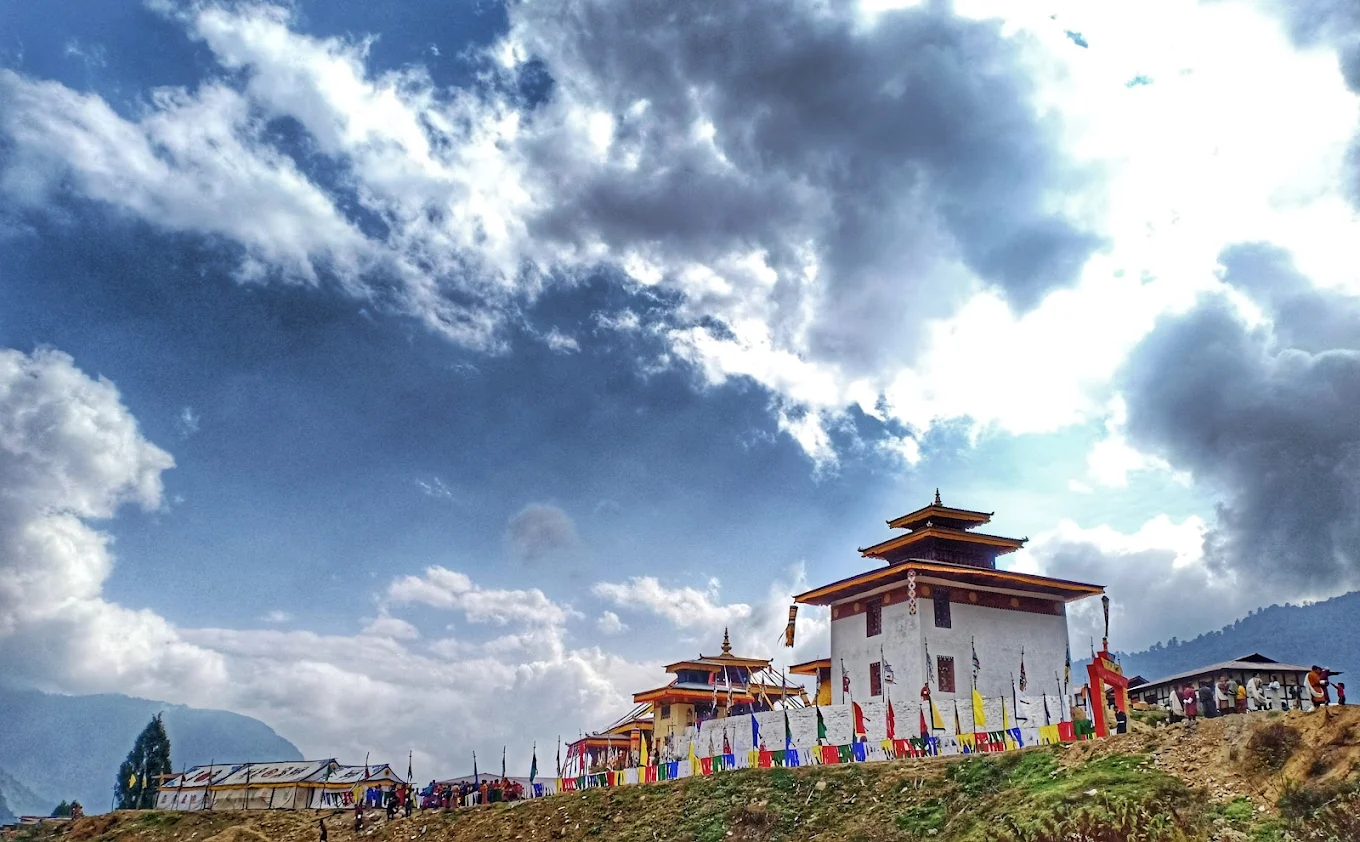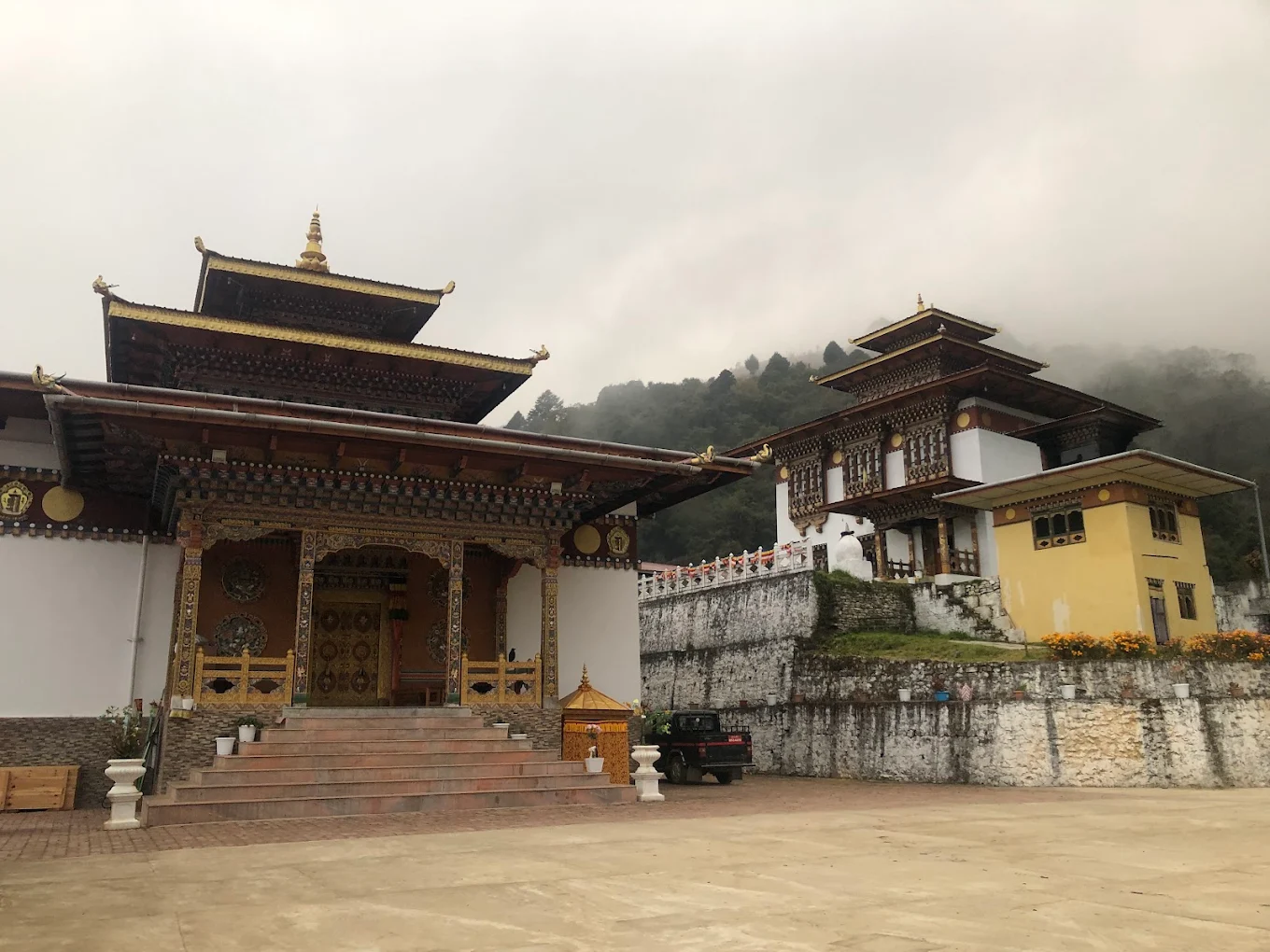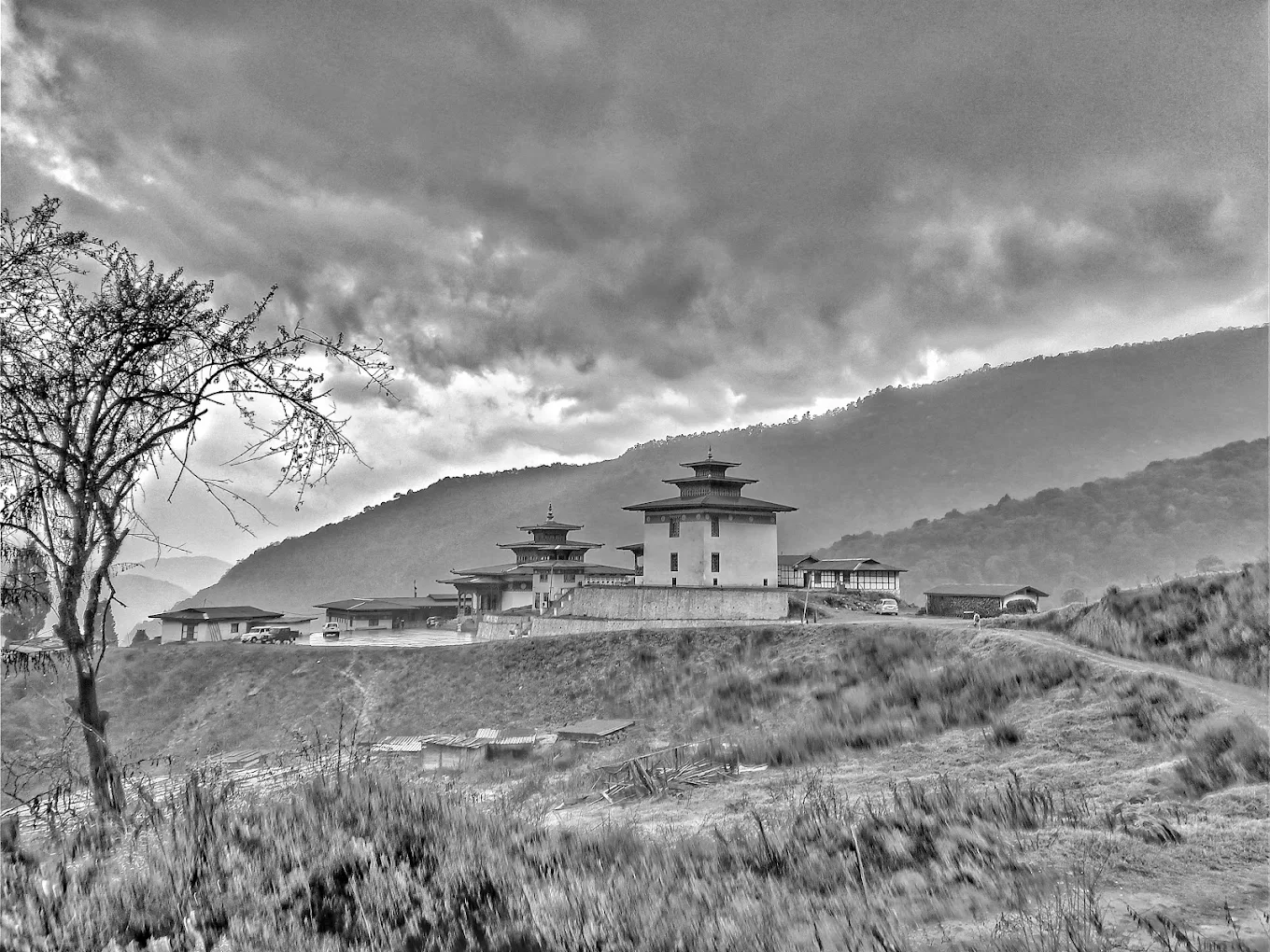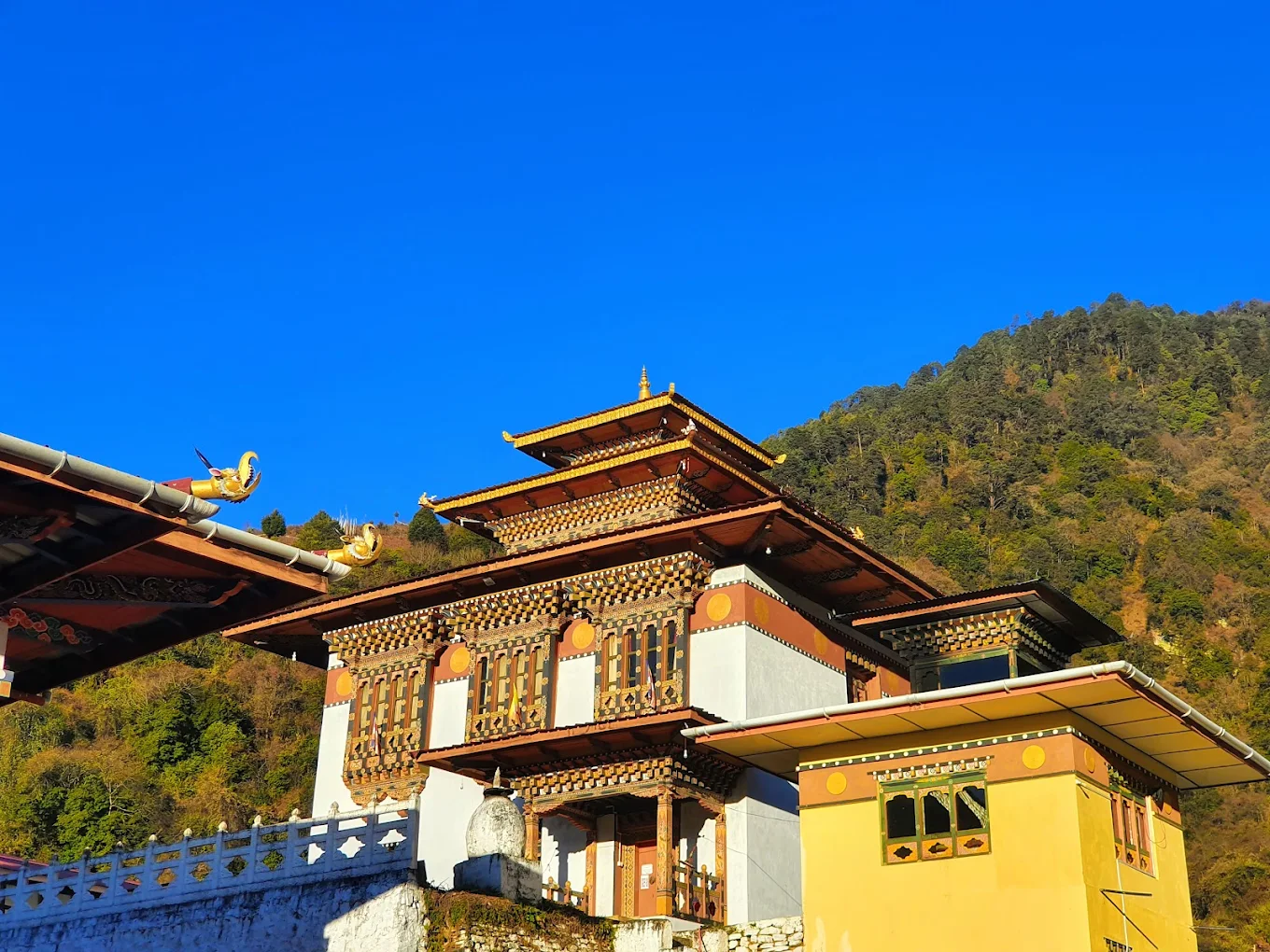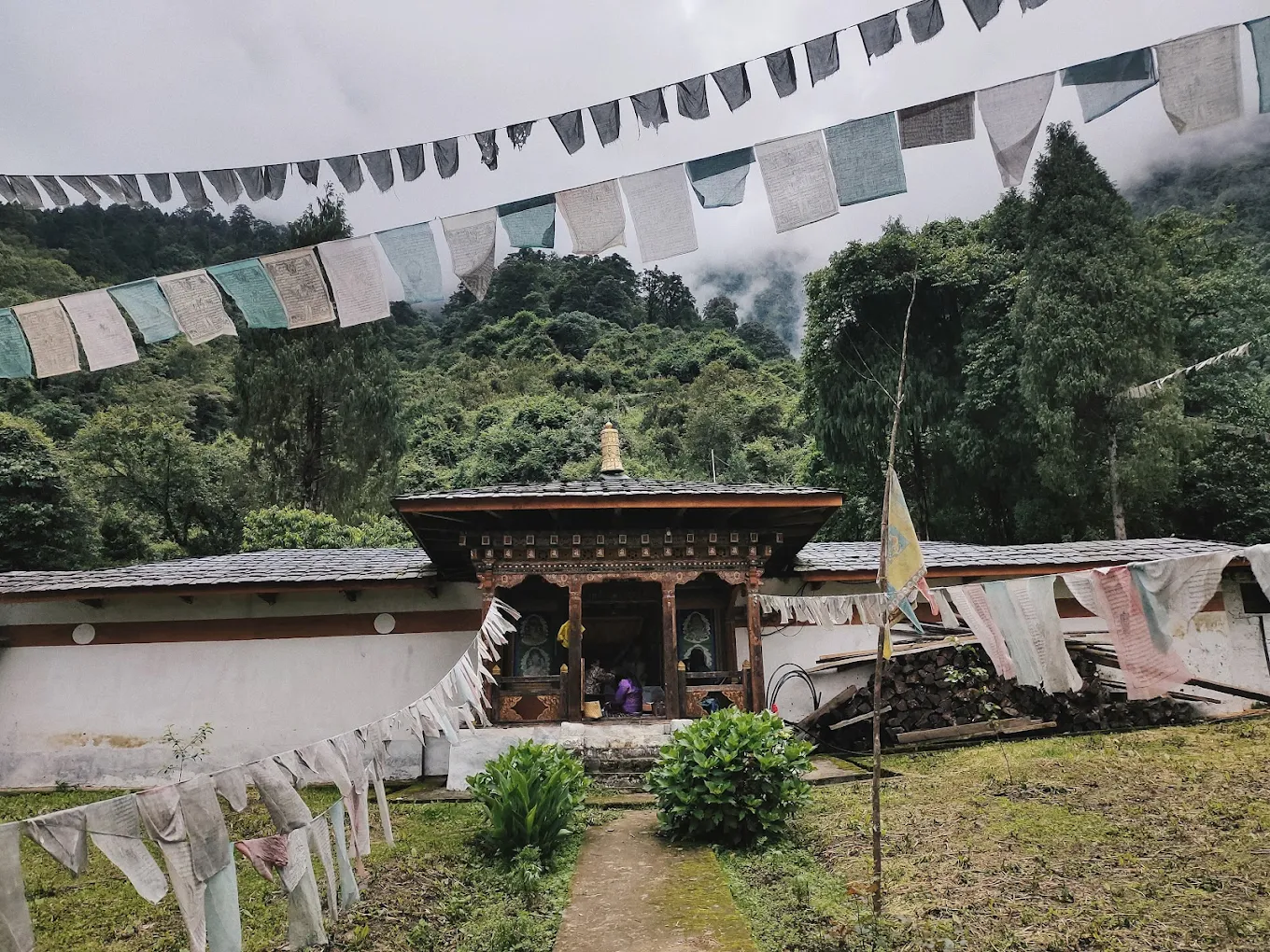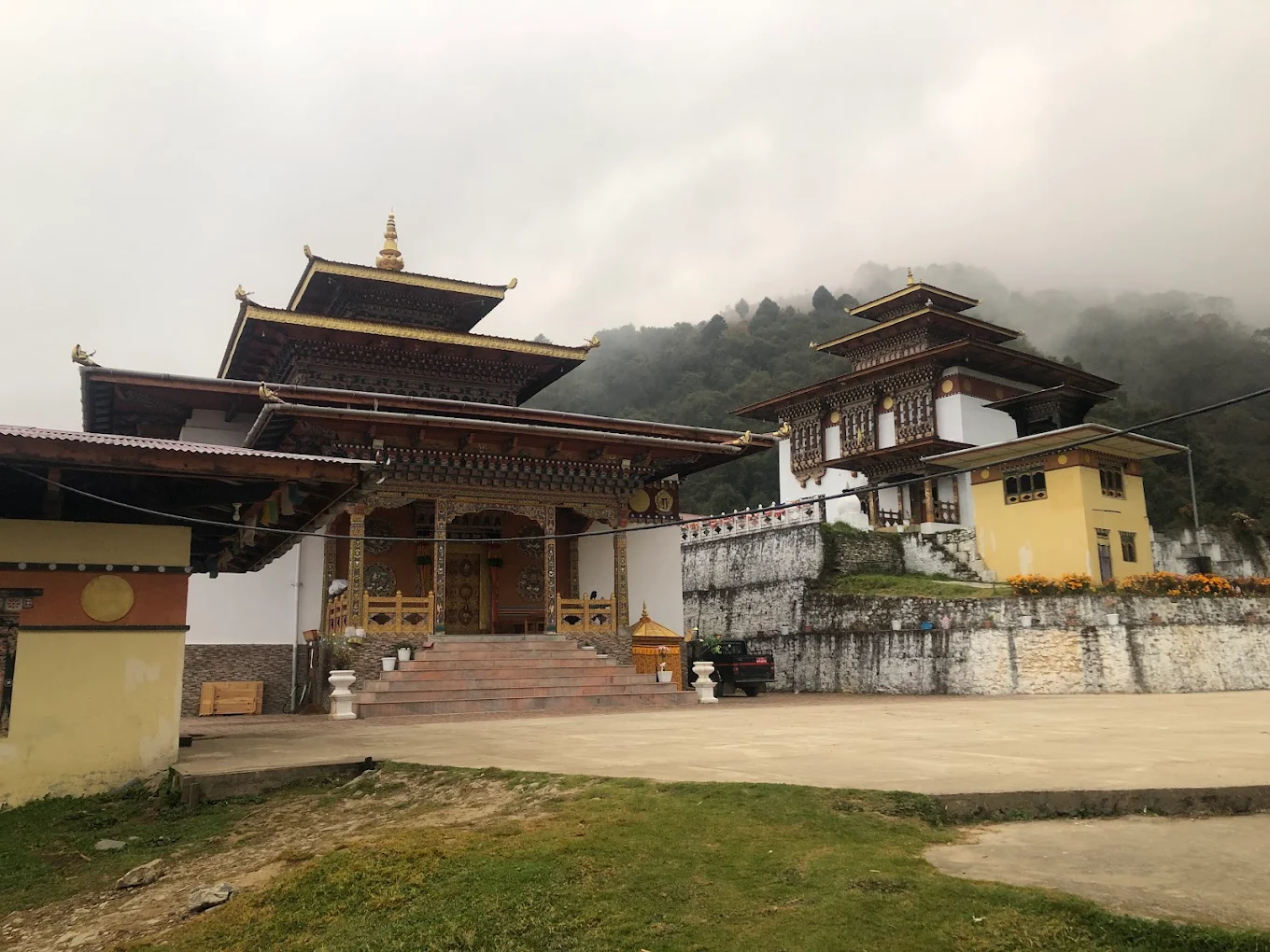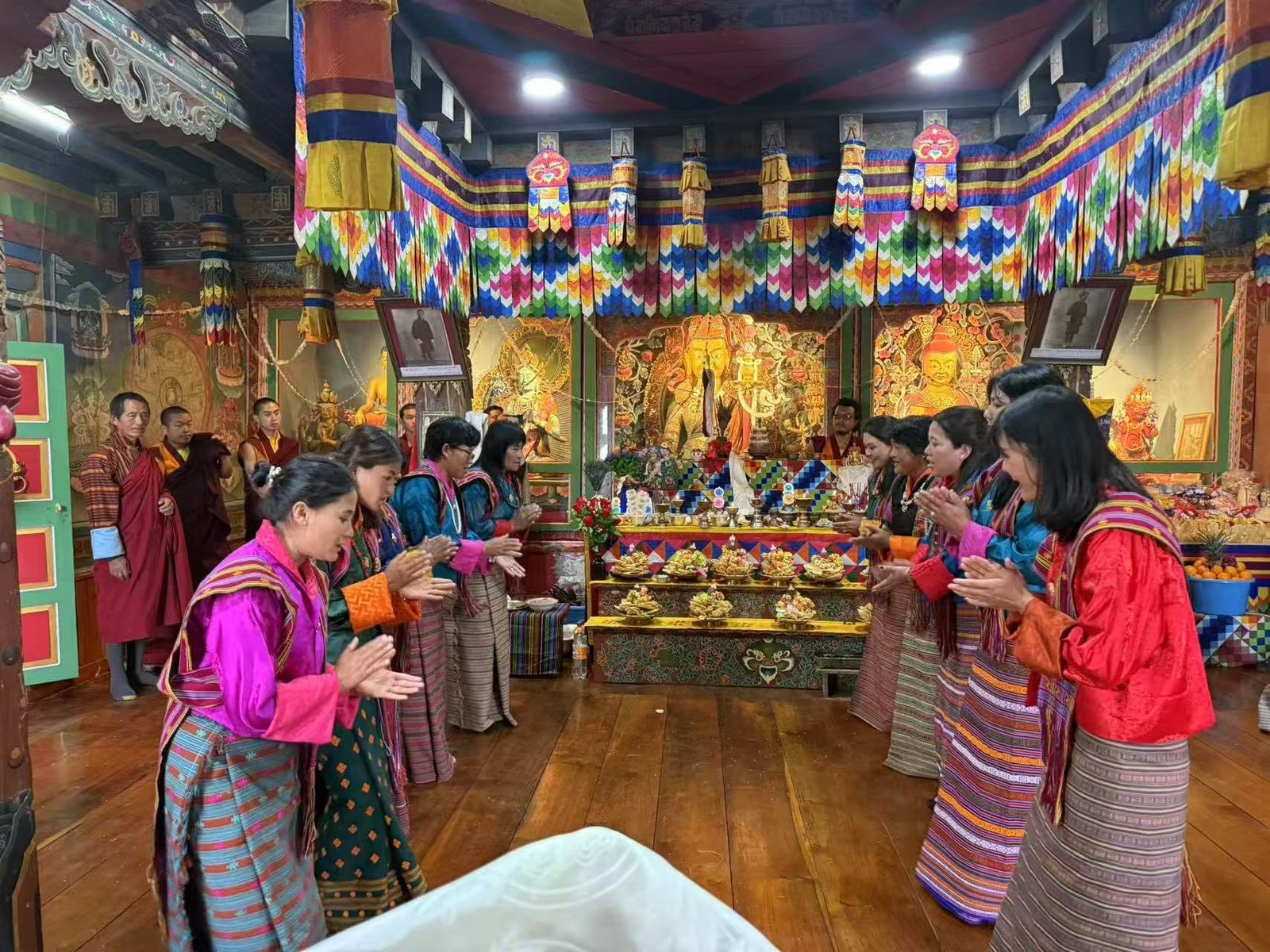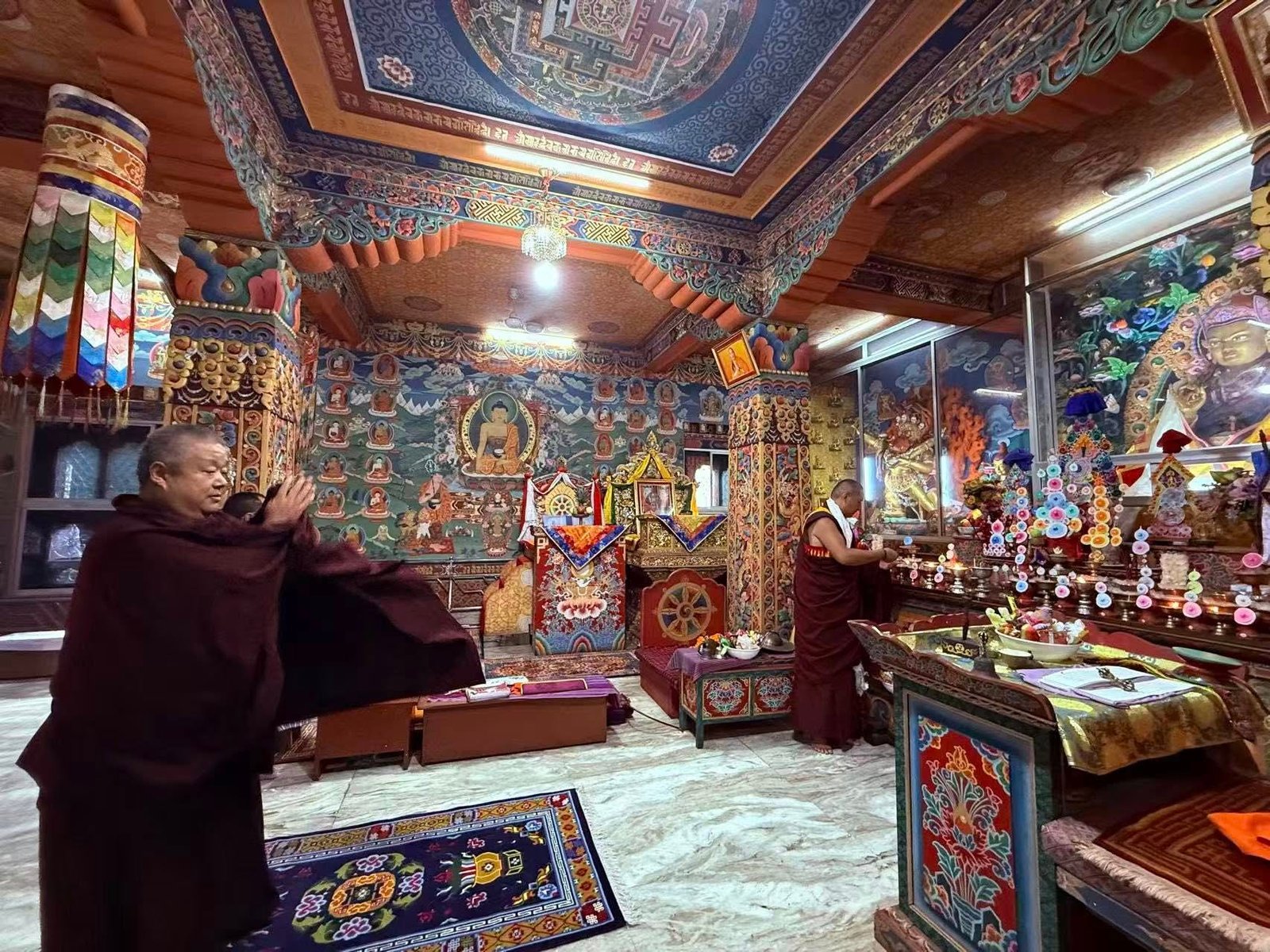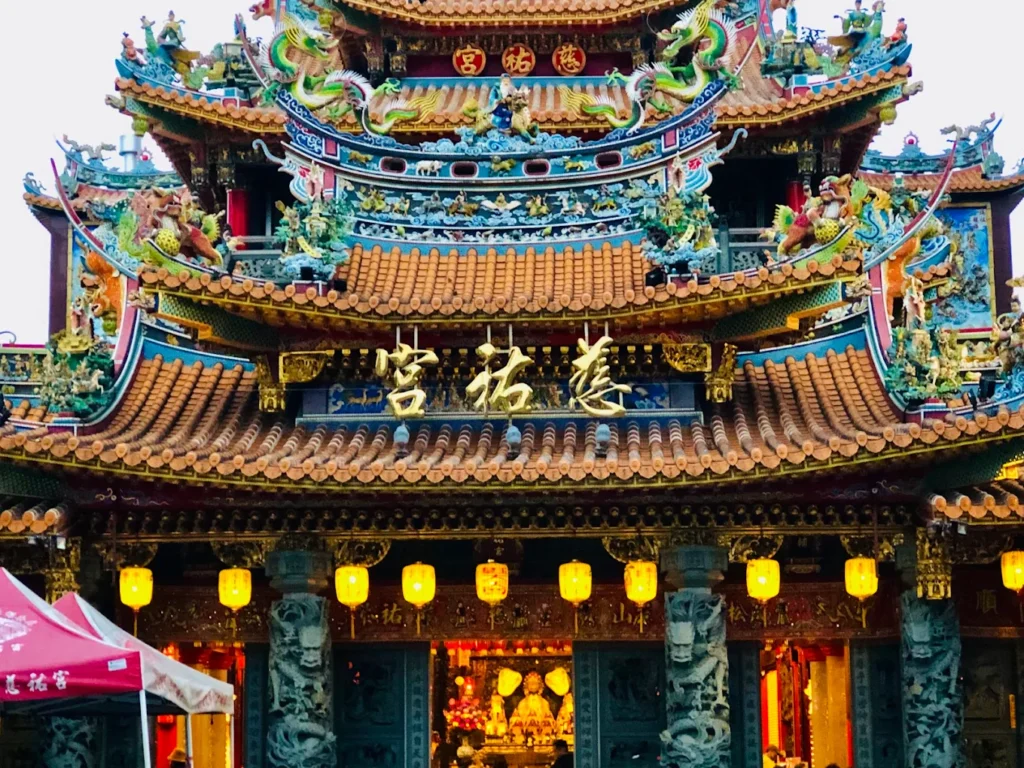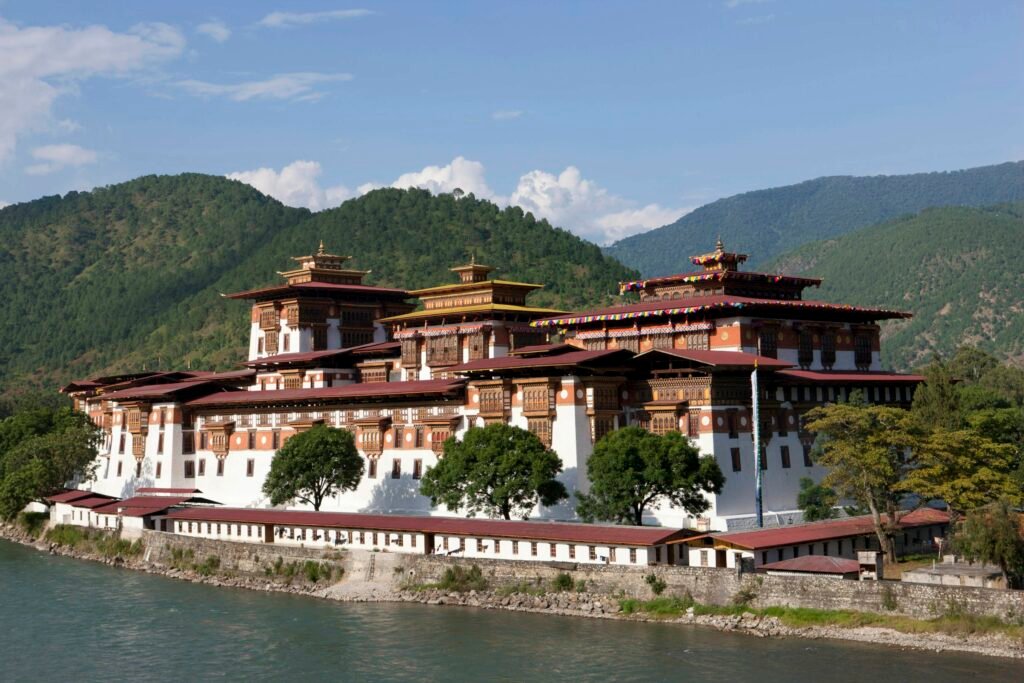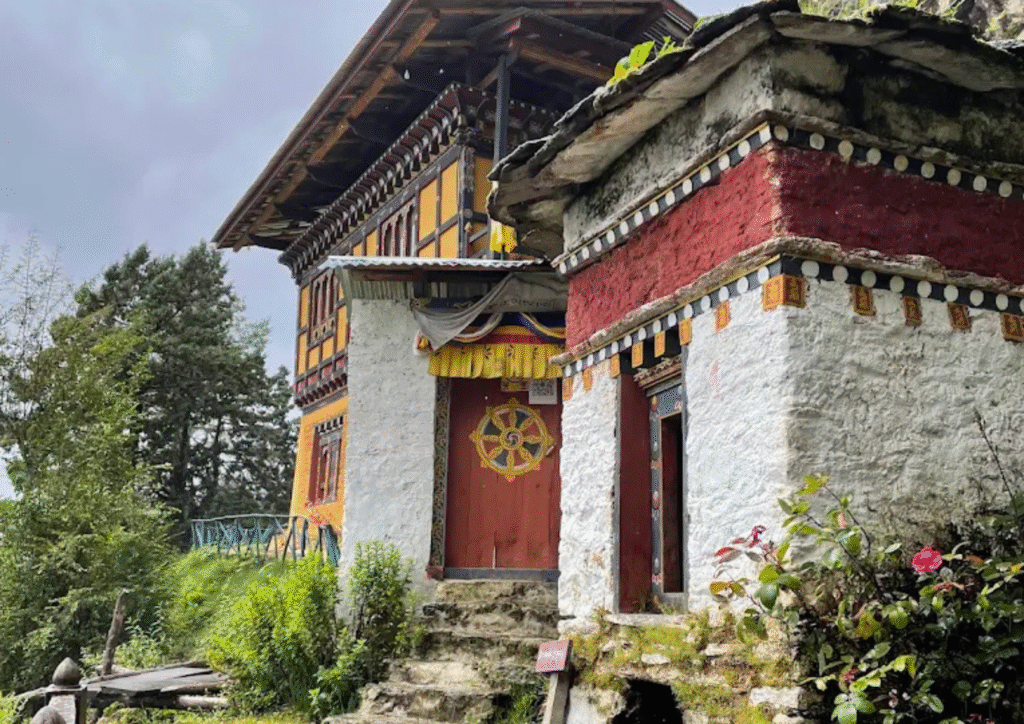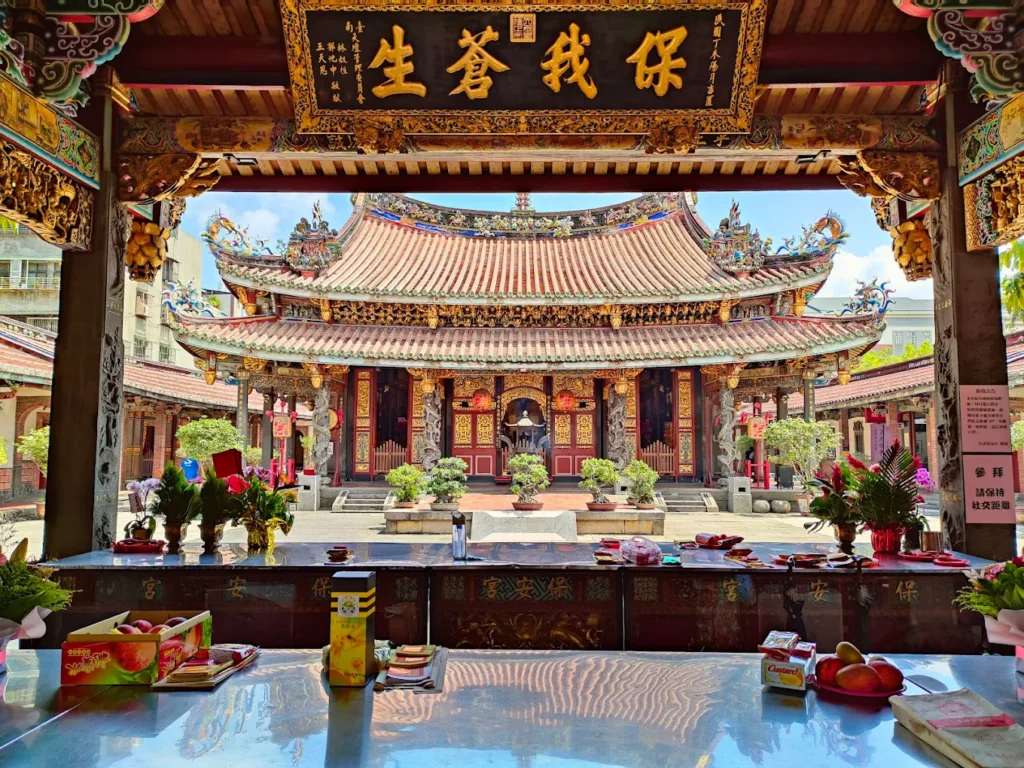Kathok Baylangdra Monastery: The Tranquil Nyingma Retreat of Wangdue’s Spiritual Valley
Nestled high in a serene valley above Wangdue Phodrang, where the morning mist weaves through a landscape of pine and rolling hills, Kathok Baylangdra Monastery stands as a quiet sanctuary, its stone walls catching the soft light of dawn. Within the sacred main temple (lhakhang), monks chant the Guru Rinpoche mantra, their voices resonating around a statue of Guru Padmasambhava, a central figure in Nyingma Buddhism. Established as a branch of the Kathok Monastery tradition, this Nyingma retreat is closely associated with Kathok Situ Rinpoche, who has led spiritual activities at the site. The air carries the scent of juniper incense, lit during prayer ceremonies, while prayer flags flutter against the breeze, blessing the surrounding valley. From its elevated perch in Wangdue Phodrang Dzongkhag, the monastery offers a tranquil connection to Bhutan’s spiritual heritage, inviting travelers, seekers, and scholars to explore its peaceful essence.
Whispers of Serenity: Overview and Significance
Introduction to Kathok Baylangdra Monastery
Kathok Baylangdra Monastery, situated high in a valley in Wangdue Phodrang Dzongkhag, Bhutan, stands as a revered Nyingma sanctuary, known for its association with Kathok Situ Rinpoche and its role as a place of spiritual retreat. A hike or drive from the Kazhi Gewog area reveals a tranquil site where the rustle of pine forests creates a peaceful ambiance. As a branch of the Kathok Monastery lineage, it embodies Bhutan’s Nyingma heritage, blending meditation with the guidance of its spiritual leader. A cultural and spiritual haven, the monastery weaves solitude, tradition, and Himalayan reverence into a modest refuge.
Historical Journey
Kathok Baylangdra Monastery’s history is tied to the broader Kathok Monastery tradition, founded in 1159 in Tibet’s Kham region by Katok Dampa Deshek. Its establishment in Bhutan, particularly at Baylangdra, is linked to the activities of Kathok Situ Rinpoche, with records of his retreats and ceremonies dating back to at least the early 21st century. The monastery has hosted significant events, such as the installation of a Guru statue in 2017 and long-life prayer recitations, reflecting its growing role under Rinpoche’s leadership. Community efforts have maintained its structures, preserving its sanctity as a retreat center.
Cultural Significance
- Nyingma Devotion: Rooted in the Nyingma school, the monastery venerates Guru Rinpoche and follows the Kathok lineage, emphasizing meditation and long-life prayers.
- Bhutanese Heritage: A spiritual retreat, it preserves rituals like mantra recitation and tse drup ceremonies, reflecting national identity.
- Spiritual Leadership: Its association with Kathok Situ Rinpoche enhances its role in Nyingma practice.
- Regional Influence: Devotees from Wangdue Phodrang and nearby areas visit, fostering community ties.
Unique Legacy
- Valley Retreat: Its high valley location offers a serene setting, distinct among Bhutan’s monasteries.
- Kathok Lineage: As a branch of Kathok Monastery, it carries the Nyingma tradition’s legacy.
- Rinpoche’s Presence: Kathok Situ Rinpoche’s retreats and ceremonies mark its spiritual significance.
- Cultural Symbol: Its solitude reflects Bhutan’s meditative heritage.
Community and Global Impact
- Local Devotion: The monastery hosts prayer ceremonies, strengthening Wangdue’s Nyingma ties.
- Pilgrimage Hub: Visitors are drawn by its retreats and Rinpoche’s blessings.
- Global Appeal: International meditators seek its Nyingma teachings and tranquil setting.
- Cultural Dialogue: Shared rituals unite Bhutanese and global visitors.
Modern Relevance
- Spiritual Retreat: Kathok Baylangdra offers a haven for mindfulness in its valley seclusion.
- Cultural Preservation: It safeguards Nyingma practices, ensuring Bhutan’s heritage endures.
- Community Role: Its ceremonies nurture Wangdue’s spiritual community.
Historical Anecdotes
- Rinpoche’s Retreat: Kathok Situ Rinpoche’s three-year retreat established its sanctity.
- Statue Installation: The 2017 Guru statue consecration marked a milestone.
- Prayer Events: Long-life prayers reflect its spiritual vitality.
Social Role
- Community Hub: Ceremonies unite Wangdue’s Buddhists.
- Meditative Center: Monks guide pilgrims in Nyingma practice.
- Charitable Spirit: Communal prayers reflect Nyingma compassion.
Artistic Influence
- Thangka Art: Simple murals of Guru Rinpoche inspire local artists.
- Cultural Icon: The valley view graces regional imagery.
- Ceremony Decor: Prayer flags showcase Bhutanese craftsmanship.
Kathok Baylangdra Monastery’s valley perch, where Kathok Situ Rinpoche once retreated, weaves a narrative of devotion and solitude that defines Bhutan’s Nyingma heritage. From its establishment as a Kathok branch to its role as a retreat center, the monastery’s history resonates with the tranquility of Wangdue Phodrang, uniting monks and pilgrims. Its sacred halls and scenic trails set the stage for a spiritual tapestry that mirrors its Himalayan soul. As we delve into its physical and spiritual features, Kathok Baylangdra’s design reveals how its serene beauty nurtures profound meditation and community faith.
Crafted by the Valley: Architectural and Spiritual Features
Iconic Design
Kathok Baylangdra Monastery’s architecture blends Nyingma simplicity with its high valley setting, creating a sanctuary that harmonizes with Wangdue’s forested landscape. Stone walls and wooden roofs, adorned with prayer flags, rise from the valley slopes, reflecting Buddhist austerity. The modest layout, centered on the main lhakhang, prioritizes meditative function, with open spaces fostering retreat. Its perch above the valley enhances its sacred resonance, tying the monastery to Bhutan’s Himalayan ethos.
Key Structures
- Main Lhakhang (Guru Lhakhang): The spiritual core, housing the Guru statue, consecrated in 2017.
- Meditation Hall: A space for retreats, used during Rinpoche’s ceremonies.
- Chorten Courtyard: A small area with prayer wheels, marking the site’s sanctity.
- Prayer Flag Poles: Structures strung with flags, dotting the valley slopes.
Worshipped Statues
- Guru Rinpoche (Padmasambhava): A bronze statue, symbolizing wisdom, radiates spiritual guidance.
- Chenrezig (Avalokitesvara): A stone statue, representing compassion, flanks the altar.
- Spiritual Role: Monks offer butter lamps to Guru Rinpoche, seeking blessings and enlightenment.
Materials and Techniques
- Construction: Local stone and timber, joined with traditional methods, ensure durability.
- Artistry: Simple murals and prayer flags, crafted by local artisans, reflect Nyingma style.
- Cultural Essence: The design prioritizes meditative retreat, distinct from larger dzongs.
Signature Elements
- Guru Lhakhang: The 2017 statue installation anchors spiritual practice.
- Valley Setting: The high perch offers a serene retreat environment.
- Prayer Flags: Fluttering flags carry blessings across the valley.
Preservation Efforts
- Maintenance: Community efforts preserve the lhakhang and grounds.
- Challenges: Weather erosion affects stonework, requiring care.
- Modern Additions: Solar lights enhance evening accessibility.
Environmental Integration
- Valley Harmony: The monastery’s design respects the local ecosystem.
- Eco-Practices: Monks maintain trails and protect flora.
- Wildlife Haven: Birds enhance the serene ambiance.
Landscape Integration
- Valley Perch: Enhances meditative focus with natural views.
- Pine Slopes: Provide solitude and spiritual resonance.
Kathok Baylangdra Monastery’s stone lhakhang and sacred spaces, nestled in Wangdue’s valley, are sanctuaries for the Nyingma practices that define its spiritual soul. The statue of Guru Rinpoche, illuminated by butter lamps, anchors rituals that connect monks to Bhutan’s spiritual lineage. These hallowed spaces, alive with chants and retreats, invite visitors to engage with the monastery’s living traditions. As we explore its rituals, Kathok Baylangdra’s role as a meditative retreat comes to life, guiding devotees toward peace and enlightenment.
Rites of the Retreat: Rituals and Practices
Daily Sacred Rites
- Morning Chanting: Monks recite the Guru Rinpoche mantra at dawn, fostering wisdom.
- Meditation Sessions: Silent meditation, held twice daily, centers on Nyingma practices.
- Butter Lamp Offerings: Devotees light lamps before Guru Rinpoche, praying for blessings.
Unique Practices
- Long-Life Prayers: Tse drup ceremonies, led by Kathok Situ Rinpoche, seek longevity.
- Retreat Meditations: Monks practice in the meditation hall during Rinpoche’s guidance.
- Signature Ritual: Offering khata scarves during statue consecrations, tied to Rinpoche’s legacy.
Festival Traditions
- Tse Drup Ceremony: A multi-day event with long-life prayers, held annually (dates vary).
- Chokhor Duchen: Celebrates the Buddha’s first sermon, with mantra recitations.
- Statue Veneration: Guru Rinpoche’s statue is adorned with offerings during ceremonies.
Visitor Engagement
- Accessible Rituals: Visitors can join chants or offer khatas, guided by monks.
- Offerings: Butter lamps and prayer flags, available at the monastery, invite participation.
- Nyingma Etiquette: Bow before statues and maintain silence during meditations.
Spiritual Community Roles
- Monastics: A small group of monks, led by Kathok Situ Rinpoche, conduct rituals.
- Lamas: Senior monks guide prayer ceremonies and retreats.
- Lay Devotees: Local villagers maintain trails and support events.
Ritual Symbolism
- Butter Lamps: Represent wisdom illuminating the mind.
- Khata Offerings: Symbolize purity and devotion.
- Mantra Chants: Invoke Guru Rinpoche’s blessings.
Monastic Life
- Daily Routine: Monks rise at 5:00 AM for chants, meditation, and maintenance.
- Community Service: Monks guide visitors and protect the site.
- Training Hub: Monks learn Nyingma practices under Rinpoche’s guidance.
Kathok Baylangdra Monastery’s rituals, from the Guru Rinpoche mantra to long-life prayers, breathe life into its valley sanctuary, connecting devotees to the Nyingma lineage. The monastery’s meditative practices, rooted in Bhutan’s spiritual faith, invite visitors to engage with its tranquil heart, whether through chants or silent retreat. For travelers, these rites offer a glimpse into Wangdue’s sacred traditions, accessible within its secluded grounds. As we turn to visitor information, Kathok Baylangdra’s valley setting guides practical planning, ensuring a meaningful journey to this peaceful retreat.
Journey to the Valley: Visitor Information
Navigating to Kathok Baylangdra Monastery
- Location: Wangdue Phodrang Dzongkhag, high in a valley above Kazhi Gewog, accessible via a trail from the valley floor.
- Landmarks: Near the Kazhi Gewog area, with limited signage in Dzongkha and English.
- Routes: Hike from the valley base (1–2 hours, moderate difficulty) or drive to the nearest access point.
Address of Kathok Baylangdra Monastery
- Dzongkha: Kathok Baylangdra Goenpa, Wangdue Phodrang Dzongkhag, Bhutan.
- English: Kathok Baylangdra Monastery, Wangdue Phodrang District, Bhutan.
Visiting Hours and Etiquette
- Hours: Open daily, 6:00 AM–5:00 PM, with ceremonies varying by schedule.
- Etiquette: Dress modestly, remove shoes before lhakhang, and avoid disturbing rituals.
- Nyingma Custom: Offer butter lamps with both hands and bow to statues.
Transport Options
- By Foot: Hike from the valley floor (1–2 hours, moderate difficulty).
- By Vehicle: Drive to the nearest road access, then walk the trail.
- By Horse: Local guides may offer horses, arranged at the base.
Accessibility and Safety
- Mobility: Steep trails may challenge those with mobility issues; no ramps available.
- Safety: Stable paths with minimal markings; carry water and layers for altitude.
- Tips: Wear sturdy hiking boots and bring a packed lunch.
Amenities and Surroundings
- Facilities: Basic restrooms near the monastery; no shops on-site.
- Nearby: Gangtey Monastery, approximately 20 km away, offers a related cultural experience.
- Dining: Picnic areas encourage packed meals, with options in nearby villages.
Immersive Visitor Tips
- Best Timing: Early morning visits offer quiet chants and cooler weather.
- Sensory Moments: Inhale pine-scented air and hear valley winds.
- Statue Connection: Offer butter lamps to Guru Rinpoche and meditate briefly.
- Ceremony Planning: Attend tse drup or statue consecration events if scheduled.
Photography Tips
- Best Angles: Capture the lhakhang at sunrise for soft light.
- Respectful Shots: Avoid photographing ceremonies without permission.
- Scenic Views: The valley offers serene landscapes.
- Equipment: A lightweight camera suits the trek.
The journey to Kathok Baylangdra Monastery, guided by Wangdue’s valley trails, is a pilgrimage that blends spiritual discovery with serene retreat, inviting visitors to engage with its Nyingma traditions. The monastery’s lhakhang and open spaces, vibrant with chants and prayers, offer a window into Bhutan’s sacred heart, where peace feels tangible. Beyond its valley beauty, Kathok Baylangdra’s cultural and spiritual significance enriches the experience, revealing the essence of Himalayan Buddhism. As we explore these insights, the monastery’s role as a beacon of tranquility and faith comes into focus, deepening our connection to its sacred legacy.
Insights of the Valley: Cultural and Spiritual Reflections
Nyingma Philosophy
Kathok Baylangdra Monastery embodies Nyingma’s core: compassion and wisdom through meditation and long-life practices. Guru Rinpoche inspires devotees, reflected in chants and tse drup ceremonies. Mahamudra teachings emphasize direct realization, guiding monks toward enlightenment.
Environmental Spirituality
The monastery’s valley perch ties it to Himalayan reverence for nature. The pine forests and rolling hills foster meditative calm, with offerings honoring local spirits. The landscape invites reflection on harmony with the natural world.
Artistic Symbolism
Simple murals depict Guru Rinpoche’s wisdom, symbolizing spiritual guidance. Prayer flags balance elements, weaving Nyingma ideals into the monastery’s aesthetic.
Community Resilience
Linked to Kathok Situ Rinpoche’s leadership, Kathok Baylangdra reflects Bhutanese devotion to the Nyingma tradition, sustained by community efforts.
Environmental Stewardship
The monastery’s slopes foster Buddhist eco-ethics. Monks protect trails and flora, urging visitors to honor the valley’s sanctity.
Meditative Practices
Nyingma meditation, including Mahamudra, cultivates awareness. The lhakhang offers spaces for retreat, guided by monks, amplifying inner peace.
Cultural Narratives
- Rinpoche’s Retreat: His presence inspires devotion.
- Statue Consecration: The 2017 event links past and present.
- Prayer Lore: Tse drup ceremonies carry Nyingma traditions.
Historical Context
- Kathok Roots: The Nyingma lineage shapes its identity.
- Rinpoche’s Era: Recent ceremonies strengthened its role.
- Community Continuity: Local support ensures its legacy.
Reflecting on the Journey
Kathok Baylangdra Monastery, cradled in Wangdue’s sacred valley, is a sanctuary where tranquility meets wisdom. Its lhakhang and open spaces, alive with Guru Rinpoche’s legacy, embody Bhutan’s Nyingma soul, inviting all to seek enlightenment. The monastery’s trails, worn by pilgrims, tell a story of devotion, rooted in Himalayan faith. Whether meditating before the Guru statue, attending tse drup prayers, or tracing Bhutan’s meditative heritage, visitors find a space to reflect and connect. As you depart, the pine scent and prayer flags’ flutter linger, a reminder that peace is always within reach.
